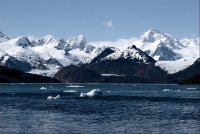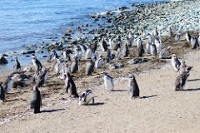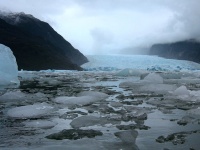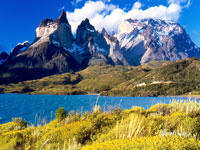
In the farthest southern reaches of Patagonia, at the tip of South America, lies the archipelago of Tierra del Fuego, which translates to 'Land of Fire'. It is a dramatic name for a dramatic place, as the harsh winds of the sub-polar climate sweep over rocky mountains, sparse tundra, and hardy forests. Tierra del Fuego is an increasingly popular eco-travel destination, and adventurous travellers come to see wildlife that includes sea lions, foxes, condors, owls, and firecrown hummingbirds. Hiking and camping are popular activities, and the archipelago offers some of the best trout fishing in South America.While the savage natural beauty of the area is the main attraction for travellers there is also more traditional touristic sightseeing on offer: much of the tourism in Tierra del Fuego revolves around 'southernmost' things. The port town of Puerto Williams claims to be the southernmost city in the world, while the southernmost cathedral and temple are located in Punta Arenas. While Cape Horn is widely thought to be the southernmost island in South America, that title actually goes to The Diego Ramírez Islands, which are nesting grounds for many species of southern seabirds, including albatross, penguins and petrels. Travellers with a sense of adventure looking to get off the beaten track will find Tierra del Fuego to be quite a revelation.

The Magdalena Island Penguin Reserve is a paradise for birdwatchers, or for anybody who is fond of penguins. Magdalena Island is located 21.7 miles (35km) south of Punta Arenas. The reserve is a natural bird sanctuary, and is home to more than 100,000 birds, including about 95 percent of the world's population of Magellanic Penguins as well as cormorants and seagulls.Because it is a sanctuary, the only facilities on Magdalena Island are for scientific research and not tourism. Guided tours are available to see the penguins in their natural habitat, and the lighthouse at the Environmental Interpretation Centre provides stunning panoramic views of the region. There are ferries available from Puntas Arenas, which take approximately two hours each way and provide snacks and coffee. These ferry rides are in themselves thrilling in that to reach Magdalena Island the boat crosses the famous Straits of Magellan, traversing the same waters as Sir Francis Drake and Charles Darwin.Generally, visitors are allowed about an hour on the island to observe the penguins in their natural habitat. The birds are naturally curious and very amusing to watch. They return every year between October and March to lay their eggs and raise their young - if you are lucky you may well see chicks.

Created in 1959, Parque Nacional Laguna San Rafael covers an area of 6,726 square miles (17,420 sq km) and includes the Northern Patagonian Ice Field. It was named after the San Rafael Lagoon that was created by the retreat of the San Rafael Glacier, and has been designated a World Biosphere Reserve by UNESCO. A fjord more than 10 miles (16km) long is one of the park's principle attractions, along with some of the highest peaks in Patagonia, several glaciers, lakes and a rich variety of bird and sea life.While the majority of visitors to Laguna San Rafael never set foot on land, the magnificent views from the boat will no doubt stay with them for a lifetime. If you take one of the larger boat trips to see the famous glaciers in the park you will almost certainly be given the opportunity to approach the ice flow in smaller boats and get up close to the glacier. For the really adventurous there are also multi-day sea kayaking tours of the area. Most visitors describe the trip as a once-in-a-lifetime, unforgettable experience and it is not hard to see why when looking at photos of the landscape. The glaciers are melting, making this attraction even more poignant and special; in a few years' time the landscape may be very different.

A UNESCO Biosphere Reserve, this 180,000-hectare (442-acre) park is the pride and joy of southern Chile. The park takes its name from the towering granite pillars that rise over 6,560 feet (2,000m) above the Patagonian plains. It is a hiker's paradise with many excellent, well-developed trails that traverse astounding changes in scenery. The hikes consist of several circuits which vary in length and difficulty; there are very competent and informative guides available, but unaccompanied hikes are also allowed. This amazing freedom is part of the appeal of the wilderness area for adventurers. Turquoise lakes and roaring waterfalls, forests and magnificent rambling glaciers, icy rivers, daisy-filled meadows, harsh mountain passes and plenty of wildlife, including the protected guanaco (wild relative of the llama), are some of its attractions.Visitors can also try their hand at outdoor activities like horseback riding, sailing and kayaking, rock climbing and fly-fishing. Two famous areas within the park are the French Valley and Silence Valley (only accessible with a guide). The sunrise hike to the towers that give the park its name is also highly recommended. For many people the world over the Parque Nacional Torres del Paine features prominently on their bucket list, and for very good reason.
Website : www.torresdelpaine.com/ingles/index.asp

Travel Guide powered by Word Travels, copyright © 2023 Globe Media Ltd. By its very nature information in this travel guide is subject to change at short notice and travellers are urged to verify information on which they're relying with the relevant authorities. Neither Globe Media Ltd nor Travel Vogue can accept any responsibility for any loss or inconvenience to any person as a result of information contained above.